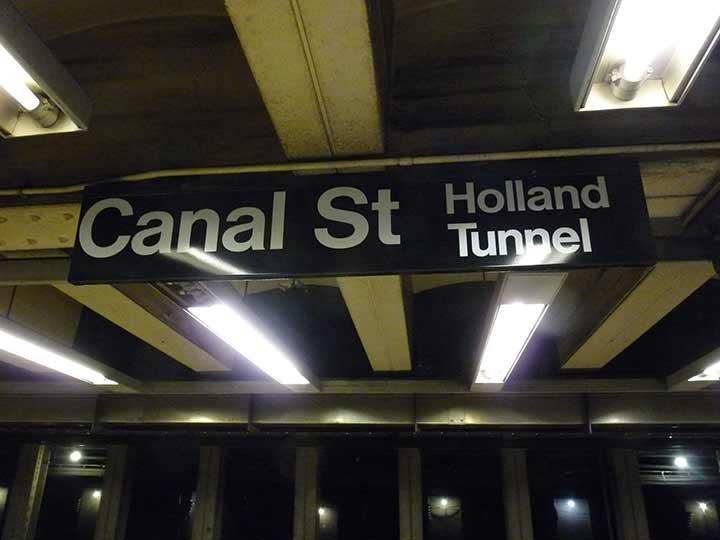
HOLLAND Tunnel engineer Ole Singstad (who replaced original tunnel engineer Clifford Milburn Holland) is little remembered today but should be mentioned in the same breath as Robert Moses and Othmar Ammann. He designed or consulted on all of NYC’s major vehicular tunnels: the Holland, Lincoln, Queens-Midtown and Brooklyn-Battery, and other major tunnels in Baltimore, New Jersey, Boston and Oakland. Singstad regretted that his tunnels were mainly used for autos and not for mass transit. The Holland, featuring Singstad’s novel ventilation system, opened in November 1927.
Speaking of mass transit, here’s a sign for the express Canal Street station on the 8th Avenue IND Line serving A, C and E trains. Notice anything unusual? I have. Think about it. What use would a subway passenger have for the Holland Tunnel? Along with expressways and most “parkways,” as well as some bridges, tunnels are reserved for auto/bus/truck use only and subway passengers have absolutely nothing to do with them. Perhaps the MTA thinks of the tunnel as a local landmark and that’s why it’s on the sign. If you have an explanation, Comments are open.
As always, “comment…as you see fit.” I earn a small payment when you click on any ad on the site. Take a look at the new JOBS link in the red toolbar at the top of the page on the desktop version, as I also get a small payment when you view a job via that link.
1/4/24


9 comments
I’m inclined to think “local landmark” probably is the explanation. I suppose you could make an argument that someone might take a subway to meet someone coming in or out by the Tunnel, and hence they’d want to know the nearest subway stop.
I can offer two possible explanations why the Holland Tunnel is the secondary name of the Canal St. Subway Station on the A, C, and E lines.
The IND station opened in 1932, while the Holland Tunnel had opened in 1927. One possibility is that the Holland Tunnel was a tourist attraction, if a pedestrian could only view its Manhattan portals on the street. Motor vehicle users obviously did not take the subway there, but there might have been some bus routes to/from New Jersey that stopped at the subway station. Remember that this was before the Lincoln Tunnel and Port Authority Bus Terminal were built.
Another possibility is that before 1932 there were already a large number of Canal Street Stations on both the IRT subways, IRT elevateds, and BMT subways. Adding “Holland Tunnel” to the station moniker was an easy way to identify the IND station.
Let’s briefly fast forward to 1980. That summer the PATH trains were on strike for two months. Many New Jersey commuters who normally would ride PATH to/from Lower Manhattan took special shuttle buses from the Hoboken NJ Transit terminal, through the Holland Tunnel, to the Canal Street IND station, where a temporary bus terminal was established outside the station. Where I worked at the time, in the World Trade Center, many of my colleagues used that service. As a Long Island resident I was unaffected, except when my job required travel to New Jersey, making me use NJ Transit commuter trains to and from Penn Station.
Otherwise, who knows. The other three Manhattan vehicular tunnels – Lincoln, Midtown, Brooklyn-Battery – do not have comparably named subway stations.
Before the Lincoln Tunnel was built about ten years later, the Holland Tunnel was how suburban and long-distance interstate buses arrived in Manhattan– the GWB as built in the meantime, and had a suburban bus plaza there before the GWB bus terminal was built oin the 1960’s, so I suppose there were stops nearby the tunnel where those passengers could board and disembark, so it may have been a way of telling Eighth Ave Subway riders where those buses were. Or, it may have been as simple as saying “This stop is not near the Manhattan Bridge and Chinatown.”
They did the same thing , mentioning a Hudson River crossing, at the 181st Street station on the #1 line. Signs in the platform in mosaic read “181st Street-George Washington Bridge”. Being that the station opened in 1906, obviously it was added after 1930 – the year of the GW’s opening.
true but one can walk across the GW Bridge
Kevin,
Aside from the vehicular tunnels there are a number of mass transit tunnels connected to Manhattan. Fodder perhaps for a future web page? Should be a piece of cake for you when you dig into your vast trove of knowledge about the city’s transit systems.
Perhaps it was a way to differentiate that station from all of the other Canal St. stations? (Back in the 80’s I saw evidence of someone trying to accomplish the same feat by blacking-out the white (on black background) “C” on the B’way line Canal St. station- thus making it “anal st.” 😀 I never forgot that! (I even found and saved a picture of it from the interwebs)
Clearing the area to build the Holland Tunnel entrance plaza prompted construction of some large, multi-use office buildings in the vicinity. I suspect city officials were trying to market that when building the IND, much like Hudson Yards on the IRT Flushing Line extension. Also to differentiate this Canal Street from the BMT/IRT stations with the same name.
There are a number of photos from around 1932 showing the wide open entrance plaza for the tunnel. Very unlike the structured lanes of today. Lots of passenger cars (and probably a good number of for-hire cars) but you can spot buses heading towards NJ. That would partially explain why the IND decided to spotlight the tunnel at the station. Here’s an example of a 1930’s bus entering the tunnel: https://cronobook.com/pic/08d2e965-3750-470c-ab3f-4ae030290fb7 .